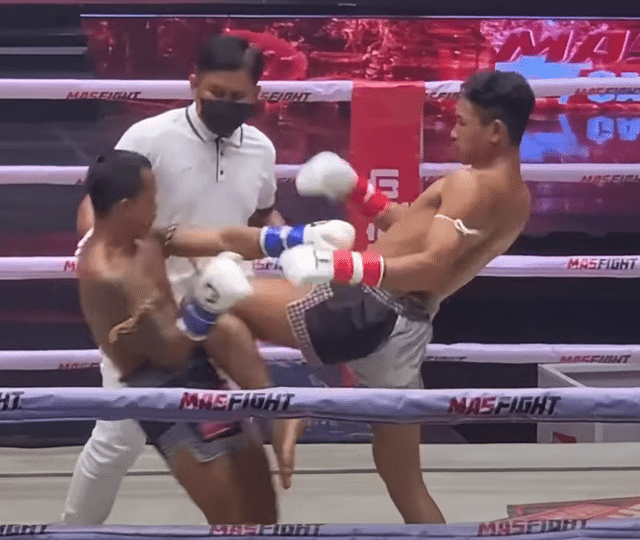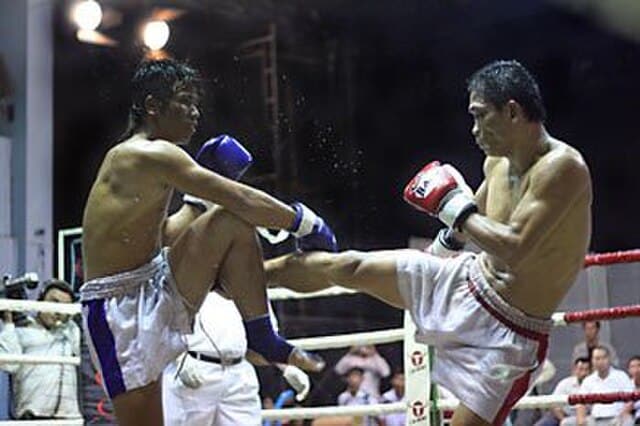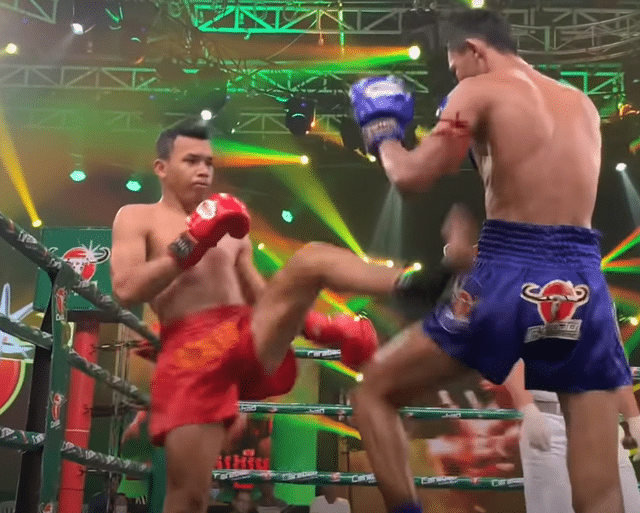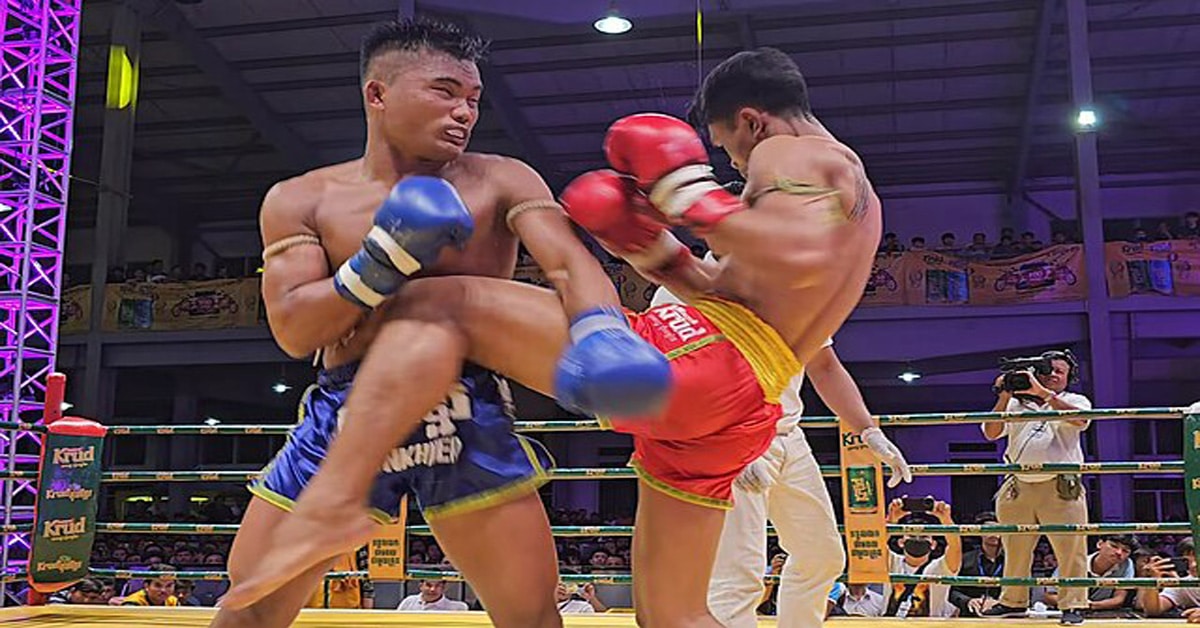Kun Khmer: Pradal Serey Is The Striking Art of Cambodia
Kun Khmer is not just a combat sport; it’s deeply entrenched in Cambodian culture and traditions. Throughout Cambodia’s tumultuous history, including periods of great empire and times of foreign occupation, Kun Khmer remained a source of national pride. Kun Khmer, also called Pradal Serey endured and has since experienced a resurgence.
Before matches, fighters perform the “Kun Kru” ceremony, a dance ritual that pays respect to their trainers, the sport, and the divine. This ritualistic dance is accompanied by traditional Cambodian music played on the “Skor Yaul” (a type of drum) and the “Sralai” (a high-pitched wind instrument).
Muay Thai and Kun Khmer officials often get into fights about what sport originated first. Most recently, this has led to widespread controversies in the SEA Games in 2023.
History of Kun Khmer
The roots of Kun Khmer can be traced back to the Angkor era, the period when the Khmer Empire dominated Southeast Asia (from the 9th to the 15th century). The temples of Angkor Wat, one of the most significant archaeological sites in the world, provide some of the earliest evidence of the martial art. The bas-reliefs on the temple walls depict scenes of warriors engaging in hand-to-hand combat, using techniques reminiscent of modern Kun Khmer.
The Khmer Empire had extensive interactions with neighboring civilizations, including the Siamese (Thais) and the Chams. These interactions, both peaceful and confrontational, likely influenced the development of Kun Khmer, infusing it with techniques and strategies from other martial traditions.
As the Khmer Empire declined and faced invasions from neighboring kingdoms, martial arts, including Kun Khmer, played a crucial role in defending the kingdom. Warriors trained in these arts became essential assets on the battlefield.
Despite the political and territorial losses, the Khmer people held onto their unique identity, with Kun Khmer being a significant part of their cultural heritage. The art form was passed down through generations, not just as a method of combat, but also as a ceremonial and spiritual practice.

Pradal Serey and Kun Khmer
Pradal Serey is believed to have ancient origins, with roots that can be traced back to the Angkor era. The bas-reliefs of the temples of Angkor Wat, which date back to the 9th century, depict scenes that are reminiscent of this martial art.
Pradal Serey incorporates a variety of techniques, including punches, kicks, elbows, and knee strikes. It is closely related to other Southeast kickboxing styles. This includes Muay Thai from Thailand, Muay Lao from Laos, and Lethwei from Myanmar.
Before a match starts, fighters perform the “krama” dance. This is a ritualistic dance that is performed to honor their teachers and ancestors.
Kun Khmer is another name for Cambodian kickboxing. While the terms Kun Khmer and Pradal Serey are often used interchangeably, some purists argue that there are subtle differences between the two in terms of techniques and traditions.
Like Pradal Serey, Kun Khmer also emphasizes punches, kicks, elbows, and knee strikes. It’s a comprehensive striking martial art that prepares its practitioners for both offense and defense.
Kun Khmer also has its own set of rituals and traditions, including the “Wai Kru” ceremony, which is similar to the “krama” dance in Pradal Serey. Fighters pay respect to their trainers, the ring, and the sport itself.

Famous Kun Khmer Fighters
There are several very famous Kun Khmer fighters such as Bun Sothea, Bird Kham, Keo Rumchong, Sen Rady, Oumry Ban, Meas Chanth, Chann Rothana (who fights using the Yutakhun Khom style), Prom Samnang, Eh Phouthong, Ot Phuthong, Yuth Phouthorng, and others.
Differences between Kun Khmer and Muay Thai
While both Kun Khmer and Muay Thai are striking martial arts from Southeast Asia, they are distinct in their style and techniques.
One of the most visually captivating aspects of both martial arts is the traditional dance performed before the commencement of a fight. In Muay Thai, this dance is known as the “wai kru”. Its origins can be traced back to the Sukhothai period, and there are numerous postures associated with this dance, each with its own significance. On the other hand, Kun Khmer features a dance known as “kun kru” or “thvayobangkoum krou”. This dance consists of 17 postures, with the majority of them deriving inspiration from the Ramayana epic, a significant piece of ancient literature in the region.
Muay Thai is accompanied by traditional music performed using a Java wind pipe, two drums, and tiny cymbals. In contrast, Kun Khmer’s traditional music is referred to as “vung phleng pradall” or “vung phleng klang khek”. The instruments used include a “sralai” (a type of pipe), two “sampho drungs” (drums), and tiny cymbals.
When it comes to the actual combat, the fighting rules for both Muay Thai and Kun Khmer are remarkably similar. Both martial arts emphasize the use of punches, kicks, elbows, and knees, and fighters train rigorously to master these techniques for their bouts.
Thailand and Cambodia Brief History
The histories of Cambodia and Thailand are deeply intertwined, characterized by shared empires, cultural exchanges, and occasional conflicts. The Khmer Empire, 802-1431 AD, with its capital at Angkor, was one of the most powerful empires in Southeast Asia. It covered parts of present-day Cambodia, Laos, Thailand, and Vietnam.
The Thais, originally from southern China, migrated into Southeast Asia and interacted with the Khmers. Over time, they established their own kingdoms, such as the Sukhothai and Ayutthaya, in present-day Thailand. The decline of the Khmer Empire in the 14th and 15th centuries was partly due to invasions from the Thai Ayutthaya Kingdom, which led to the capture of Angkor in 1431.
After the decline of the Sukhothai Kingdom, the Ayutthaya Kingdom emerged as the dominant power in the region. The kingdom had multiple conflicts with the Khmer Empire and later with Cambodia, but it also absorbed many aspects of Khmer culture, architecture, and governance.
For example, the Khmer script and the Thai script have similarities, both originating from the ancient Brahmi script of India. Many Khmer words found their way into the Thai language due to cultural exchanges over centuries. This is in addition to similarities when it comes to architecture, religion, and ceremonies.
Traditional ceremonies, such as those related to rice cultivation and the lunar calendar, are celebrated in both countries, though they might have different names and customs. Water festivals, marking the end of the rainy season, are significant in both Cambodia (Bon Om Touk) and Thailand (Songkran).
Cambodia is also home to the martial art Bokator. This form of combat is thousands of years old and was used by the military. It was a striking and grappling martial art, not used in competition, but instead used on the battlefield.

The Fight Over the Origin
The debate over the origins of Kun Khmer and Muay Thai and which came first is a contentious issue that involves both national pride and historical interpretations.
Both Cambodia and Thailand have ancient martial traditions that involve striking with fists, elbows, knees, and shins. These traditions have been practiced for centuries and are deeply embedded in the respective cultures of the two countries.
The Khmer Empire, which existed between the 9th and 15th centuries, left behind depictions of fighters in combat postures on the walls of the Angkor Wat temples. Some believe these to be early representations of Kun Khmer.
In Thailand, ancient chronicles and manuscripts describe a martial art practiced by warriors, which is believed to be an early form of Muay Thai.
Some Cambodians argue that since the Khmer Empire predates the Thai kingdoms, and given the evidence of fighting styles depicted in Angkor Wat, Kun Khmer is the original form from which Muay Thai evolved. They suggest that as the Siamese (ancient Thais) interacted with and sometimes fought against the Khmer, they might have adopted and adapted aspects of Kun Khmer into their martial traditions.
As Muay Thai gained international recognition and popularity in the 20th and 21st centuries, some Cambodians felt that Kun Khmer, with its equally rich history and technique, was being overshadowed. This has contributed to sensitivities around the topic.
SEA Games Controversy
Muay Thai has a history of participation in the SEA Games, having been included five times in the past. It was held in the years 2007, 2009, 2013, 2019, and most recently in 2022. This Thai martial art has been showcased multiple times, reflecting its popularity and significance in the Southeast Asian sporting arena.
In 1995, Cambodia proposed a name change for Muay Thai at the SEA Games. They suggested referring to it as “Sovannaphum boxing” or “SEA Boxing”, a title representing not just Thailand but also Cambodia, Laos, and Myanmar. The term “Sovannaphum” translates to “golden land” in Khmer, while in Thai, it’s written as “Suwannabhumi”.
However, this proposal was met with resistance, especially from Thailand. The Thai representatives argued that their nation played a pivotal role in popularizing its boxing style on the international stage.
In 2032, instead of Muay Thai, there was Kun Khmer, the event was hosted in Cambodia. Due to this, Thailand refused to participate. Ultimately, Cambodia took home most of the medals followed by Vietnam.
Kun Khmer is rooted in ancient practices, its techniques are depicted in the intricate bas-reliefs of the iconic Angkor Wat temples, hinting at a legacy that spans over a thousand years. More than just a fighting style, Kun Khmer is deeply interwoven with Cambodian traditions, from the ceremonial “kun kru” dance performed before matches to the rhythmic beats of “vung phleng pradall” that accompany bouts. As this martial art makes its debut in the 2023 SEA Games. The striking art Kun Khmer is a source of great national pride for Cambodia.

